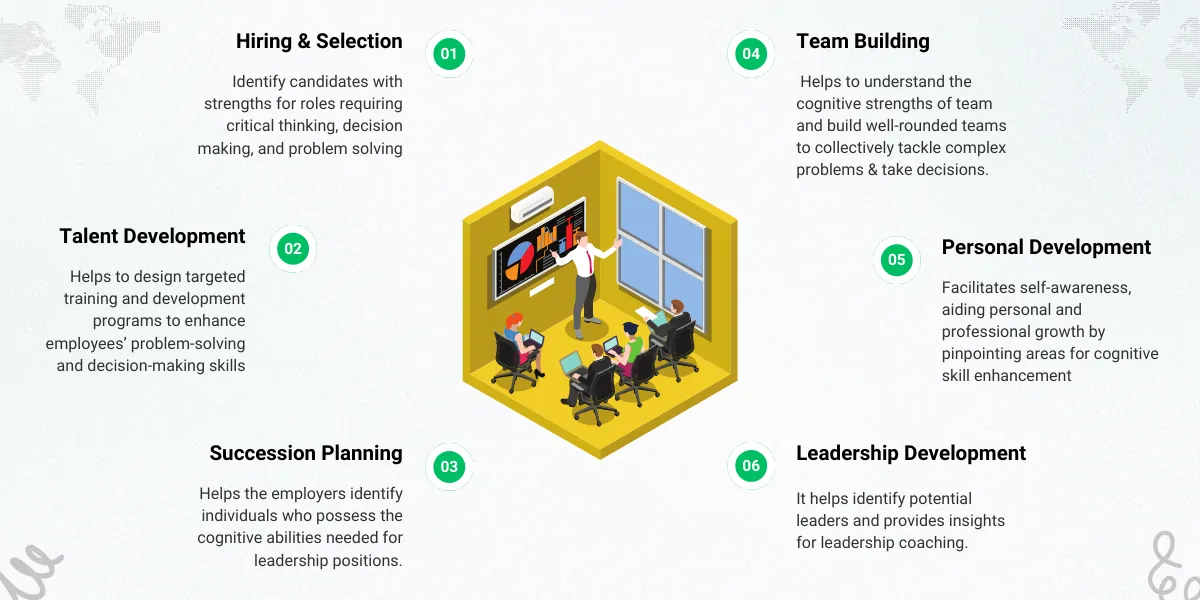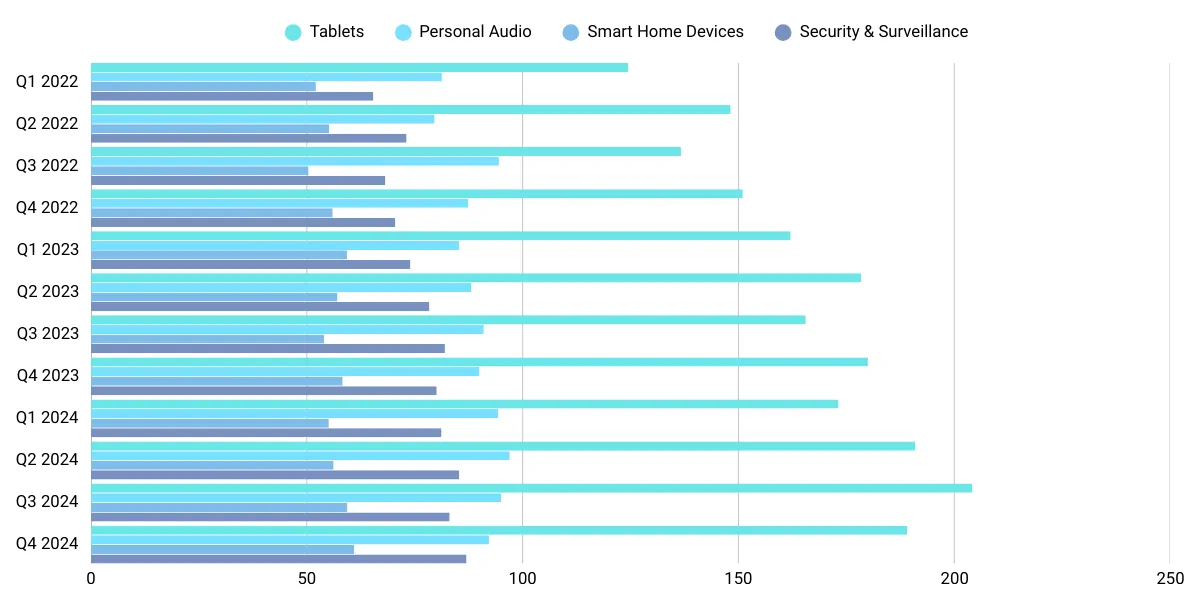Hogan Business Reasoning Inventory: Be Exam Ready in 2025 with Free HBRI Practice Test
- Overview
- Sample Questions
- Curriculum
- Instructor
Hogan’s Business Reasoning Inventory (HBRI) is an important step for many professionals aiming to advance their careers. Employers often use it to guide hiring, promotion, and development decisions, so a strong score can make a real difference. Whether you’re moving into management, exploring new job opportunities, or already established in your field, preparing well is key.
Our 2025 HBRI Prep Course has been fully updated to match the latest test format. It walks you through the exam structure, the different types of questions, and how scoring works. You’ll find a wide range of practice questions designed to reflect the new style, along with clear explanations and practical tips to help you improve.
We focus on the skills that matter most—numerical reasoning, verbal analysis, and logical thinking—so you can strengthen your performance where it counts.
With the right preparation, you can approach the HBRI with confidence and turn your score into a career advantage.
What Is Hogan HBRI Assessment and What Does It Measure?
The Hogan Business Reasoning Inventory (HBRI) is a 25–30 minute assessment developed by Hogan Assessment Systems. It’s widely used in hiring and talent development to understand how people think—not just what they know. The HBRI focuses on how you approach problem-solving and decision-making in realistic, complex business situations.
In a fast-changing corporate landscape, organizations around the world rely on the HBRI to gain a clear picture of the cognitive strengths of both potential hires and current employees. The insights help ensure they have the right minds in place to meet today’s challenges and adapt to tomorrow’s.
The HBRI measures two key areas:
- Quantitative Reasoning – Assesses how well you work with numbers. This includes solving math problems, interpreting numerical data, and making informed decisions based on figures—skills that are vital for roles involving budgeting, data analysis, and financial planning.
- Qualitative Reasoning – Evaluates how you think using language, concepts, and logic rather than numbers. This involves reading comprehension, critical thinking, and the ability to make sound decisions from written or conceptual information—crucial for roles requiring analysis of reports, policies, or written communications.
In short, the HBRI is more than an assessment—it’s a trusted tool for identifying the cognitive abilities that drive success in the business world.
How does Hogan HBRI Fits in the Workplace

Success Stories
4.8 267 Reviews
rob, 16 Jan
Solid review course that covers the…
Solid review course that covers the relevant topics in good detail
chad, 11 Jan
Great Program, amazing practice simulations
Easy to understand. Passed tests on first time thru.
QUEEN RIGHTEOUS, 07 Jan
Highly recommended.Great instructional…
Highly recommended.Great instructional information. I passed on the first try.
Erik Todd, 19 Dec
I was apprehensive at first about the…
I was apprehensive at first about the training, but decided to take a leap and try it. Certainly gave me an overall understanding of the assessment so I more confidently answered the questions in the actual assessment. I found it very useful as a practice to lower test anxiety and feel more confident in how I answered questions
MasterCommand, 14 Nov
Prepterminal. Prepare, practice, execute.
To say that Prepterminal helped me prepare and be ready for the testing phase would be an understatement. At first, looking at the course, I felt overwhelmed with the course material, but the course broke down each subject effectively which made it easier to understand. There were a few issues with some of the audio portion of the testing course, but beyond that, the course was well worth the money.
Abazix LLC, 09 Nov
Would recommend
Study material helped to pass my test on the first try.
HBRI Question Types & Format
The HBRI measures key cognitive skills that are essential for making sound business decisions. It features a variety of question types, each aimed at evaluating specific reasoning abilities in candidates. Below are the main areas the test covers:
Numerical Reasoning
This measures how effectively a person works with numbers and applies mathematical thinking. Tasks may involve calculating a product’s profit based on its cost and selling price, or reviewing a financial report to identify changes in revenue and expenses. These abilities are crucial for roles that involve managing budgets, analyzing financial performance, and making data-driven business decisions.
Example of Numerical Reasoning Questions
The graph below shows quarterly revenues (in $ millions) from 2022 to 2024 for four market categories — Tablets, Personal Audio, Smart Home Devices, and Security & Surveillance
A category is considered High Performing in a given year if:
- Its average quarterly revenue for that year is at least 8% higher than the average quarterly revenue for the same category in the previous year, and
- It has at least 2 quarters in that year where revenue is higher than any quarter in the previous year.
-
A:
Tablets
-
B:
Personal Audio
-
C:
Smart Home Devices
-
D:
Security & Surveillance
Explanation:
From the graph:
- Tablets — Shows a clear, large increase in both transitions (2022→2023 and 2023→2024) and multiple quarters in each new year exceed the previous year’s peak → High in both years.
- Personal Audio — Revenue rises slightly in 2024 but not enough to visually suggest an 8% average increase in either transition → Never High.
- Smart Home Devices — Has some quarters above the previous year’s max, but the overall average barely changes visually → Never High.
- Security & Surveillance — Large jump in 2023 with several quarters clearly above 2022’s peak; in 2024, the increase is modest and visually below the 8% threshold → High only once.
Verbal Reasoning
This assesses how well a person understands and interprets written information. It measures the ability to grasp meaning from text and critically evaluate its content. Tasks may include reviewing a detailed business report and identifying its key points, or analyzing a written plan to determine its strengths and weaknesses. These skills are essential for roles that require clear communication, critical thinking, and strong comprehension of written material.
Examples of Verbal Reasoning Questions
Passage:
The marketing department of Orion Technologies proposed a new product launch plan aiming to introduce their AI-powered scheduling tool in Q3. The plan includes a $1.2 million advertising budget, targeted primarily at mid-sized enterprises in the healthcare sector. It highlights an expected 20% market penetration within the first year, citing strong demand due to increasing administrative automation needs. However, the proposal does not address potential competition from two major players already offering similar tools with established market presence. Additionally, the timeline for development and testing is not detailed, leaving uncertainty about meeting the Q3 launch goal.
-
A:
Key point: $1.2 million advertising budget; Weakness: Lack of pricing strategy.
-
B:
Key point: Targeting healthcare enterprises; Weakness: No competitor analysis.
-
C:
Key point: Expected 20% market penetration; Weakness: Unclear development timeline.
-
D:
Key point: AI-powered scheduling tool; Weakness: Absence of a marketing budget.
Explanation:
Let’s check each option against the passage:
A) Key point: $1.2 million advertising budget; Weakness: Lack of pricing strategy.
The budget is correct (stated in the text).
But the passage never mentions pricing at all — so while lack of pricing might be a weakness in real life, it’s not stated in the passage. ❌
B) Key point: Targeting healthcare enterprises; Weakness: No competitor analysis.
Target audience is correct (mid-sized healthcare enterprises).
But competitor analysis is partially mentioned — the plan ignores two major players, which is a competitor consideration, but the weakness is actually “failure to address competition,” not “no competitor analysis” outright. This wording is misleading. ❌
C) Key point: Expected 20% market penetration; Weakness: Unclear development timeline. ✅
The 20% market penetration target is explicitly stated.
The missing development/testing timeline is clearly described in the last sentence as a source of uncertainty for meeting the Q3 launch. Both parts are explicitly supported by the passage. ✔✔
D) Key point: AI-powered scheduling tool; Weakness: Absence of a marketing budget.
Product description is correct.
But there is a marketing budget — $1.2M — so the weakness is factually wrong. ❌
Abstract Reasoning
This measures a person’s ability to think visually and solve problems without relying on words. It focuses on spotting patterns, relationships, and connections in images, diagrams, or designs. Tasks might include completing a sequence of shapes or identifying the missing element in a visual pattern. These skills are valuable in roles that require creative problem-solving, strategic thinking, and the ability to see the bigger picture.
Examples of Abstract Reasoning Questions

-
A:

-
B:

-
C:

-
D:


Explanation:
Solution Explained
Observe: This series is made up of a set of shaded and unshaded circles. These start at 20 in number and steadily decrease as they progress across the boxes. They also clump together as they progress.
Identify: There are three patterns at play here. The first dictates the number of circles in each box. Box 1 contains 20 circles, an even split of shaded and unshaded ones. As they move across the boxes, they decrease by a count of 2 each time. The even split between the two colors is maintained.
The second pattern pertains to the grouping together of the circles into different configurations. In Box 1 each circle stands apart from its peers. In Box 2, we see that the previous circles have arranged themselves into duos. This pattern continues with each successive box as these groups increase by a count of one, leading to groups of three and four in Boxes 3 and 4 respectively. Those circles that are left after the grouping still seem to clump together making their own smaller groups.
The third pattern is perhaps the easiest to spot, ensuring there is always an even split between the shaded and unshaded circles in each box.
Verify: Box 1 contains 20 circles standing separately. Box 2 contains 18 circles in groups of two. Box 3 contains 16 circles in groups of three and one leftover. Box 4 contains 14 circles in groups of four and two leftovers. There are always the same number of both colors of circles in each box.
Apply: Based on these observations, the missing box should contain two fewer circles than Box 4 with 14. So it will have a total of 12 circles with 6 shaded and 6 unshaded ones. They will be arranged in two groups of 5 circles each and two leftover.
Therefore, the only image that matches that description is Option D.

Hogan HBRI QuickPass Prep
Last Updated: Aug 14, 2025
Course Content
-
1Introduction 2 StepsBuy this Course: Get full access to all lessons, practice tests and guides.
-
2Reading Comprehension 4 StepsBuy this Course: Get full access to all lessons, practice tests and guides.
-
3Word Analogies 6 StepsBuy this Course: Get full access to all lessons, practice tests and guides.
-
4Writing Ability 4 StepsBuy this Course: Get full access to all lessons, practice tests and guides.
-
5Basic Math 4 StepsBuy this Course: Get full access to all lessons, practice tests and guides.
-
6Word Problems 4 StepsBuy this Course: Get full access to all lessons, practice tests and guides.
-
7Number Series 4 StepsBuy this Course: Get full access to all lessons, practice tests and guides.
-
8Data Visualization 4 StepsBuy this Course: Get full access to all lessons, practice tests and guides.
-
9Deductive Reasoning 4 StepsBuy this Course: Get full access to all lessons, practice tests and guides.
-
10Inductive Reasoning 4 StepsBuy this Course: Get full access to all lessons, practice tests and guides.
-
11Next in Series 4 StepsBuy this Course: Get full access to all lessons, practice tests and guides.
-
12Abstract Analogies 4 StepsBuy this Course: Get full access to all lessons, practice tests and guides.
-
13Odd One Out 4 StepsBuy this Course: Get full access to all lessons, practice tests and guides.
-
14Matrices 4 StepsBuy this Course: Get full access to all lessons, practice tests and guides.
-
15HBRI - Full Length Practice Quiz 2 StepsBuy this Course: Get full access to all lessons, practice tests and guides.
Preparing for the HBRI: Tips and Strategies
Below are practical tips and strategies designed specifically for the Hogan Business Reasoning Inventory (HBRI) to help you perform at your best:
Numerical Reasoning
- Master Core Concepts – Make sure you can confidently work with percentages, ratios, averages, and basic data interpretation. These form the backbone of most numerical reasoning questions.
- Work on Speed and Comfort – Regularly practice quick calculations in your head—such as multiplying small numbers or finding percentage increases—so you’re not slowed down during the test.
- Check Before You Commit – A fast wrong answer won’t help your score. Take a few seconds to confirm your calculation before moving on.
- Use Smart Shortcuts – If exact calculations take too long, use rounding or estimation to get close enough to spot the correct answer.
- Decode Data Visuals – Don’t skim graphs, tables, or charts—read titles, labels, and scales carefully. Many errors come from misreading what’s actually being shown.
- Practice Under Time Pressure – Simulate real test conditions so you learn to balance speed and accuracy without panicking when the clock is ticking.
Verbal Reasoning
- Build a Strong Vocabulary – Read widely—business articles, industry reports, and quality journalism—to naturally expand your vocabulary and improve your ability to interpret complex text.
- Identify Key Information – As you read, highlight or mentally note words and phrases that reveal the main idea, important facts, or relationships between concepts.
- Sharpen Reading Comprehension – Practice with varied materials, including reports and opinion pieces, to train yourself to process information quickly while retaining accuracy.
- Use Process of Elimination – For multiple-choice items, remove any answers that are clearly wrong to improve your odds of selecting the correct one.
- Leverage Context Clues – When you encounter unfamiliar terms, use the surrounding sentences and ideas to infer their meaning without losing time.
- Practice Under Test Conditions – Work on timed reading comprehension exercises so you can balance speed with understanding during the actual assessment.
Abstract Reasoning
- Train Your Pattern Recognition – Abstract reasoning questions often hinge on spotting patterns and relationships between shapes, symbols, or sequences. Practice until you can identify these quickly and confidently.
- Practice with a Timer – Since the HBRI is time-limited, get used to working under pressure. Timed practice helps you balance speed with accuracy.
- Understand Grouping Rules – Many questions require classifying objects or shapes based on shared features like size, number, or orientation. Learn to spot these grouping criteria at a glance.
- Watch for Symmetry and Rotation – Pay close attention to how shapes are flipped, rotated, or mirrored—these transformations are common in abstract reasoning tasks.
- Use Elimination Wisely – If a pattern isn’t immediately clear, cross off any options that obviously don’t fit. Narrowing the field can make the correct answer stand out.
- Visualize the Sequence – When possible, mentally picture the next step in a pattern before checking the answer choices—it can help you confirm the logic quickly.
Advantages of Our HBRI Prep Course
Extensive Practice Bank – Tackle 120 Numerical Reasoning, 120 Verbal Reasoning, and 60 Abstract Reasoning questions—each designed to match the updated 2025 HBRI style. This variety ensures you’re ready for any challenge the test throws your way.
All-Round Skill Boost – Strengthen your numerical, verbal, and abstract reasoning skills so you can think faster, analyze better, and solve problems from multiple angles.
Practice Your Way – Choose between untimed quizzes for stress-free learning or timed sessions to simulate real exam pressure.
Real Test Experience – Our timed quizzes replicate the pace and pressure of the actual HBRI, helping you walk into test day confident and prepared.
Track Your Progress – See exactly where you’re improving and where you need more focus, so you can target your efforts for maximum score gains.
Expertly Crafted Questions – Every question is written to match the complexity, logic, and reasoning style of real HBRI items, so nothing feels unfamiliar on test day.
Learn Anywhere, Anytime – Access the course on any device, so you can fit practice into your schedule—whether you’re at home, on your commute, or on a lunch break.

Created by: Michael Learner
Psychometric Test Expert
481 students, 4.8, 267 Reviews
Hey, I’m Michael, PrepTerminal’s Business Reasoning expert. I am here to help you with any questions or concerns you may have about the Hogan Business Reasoning Inventory. Feel free to contact me at [email protected].
